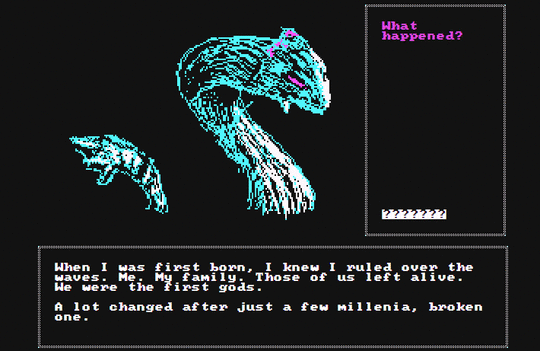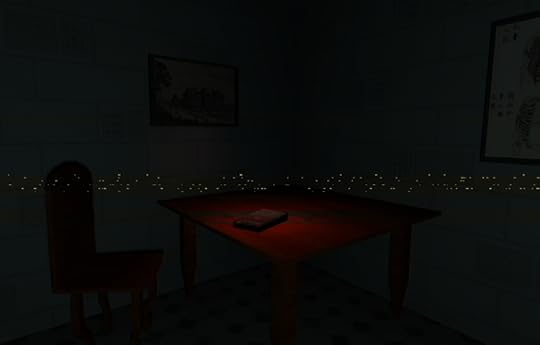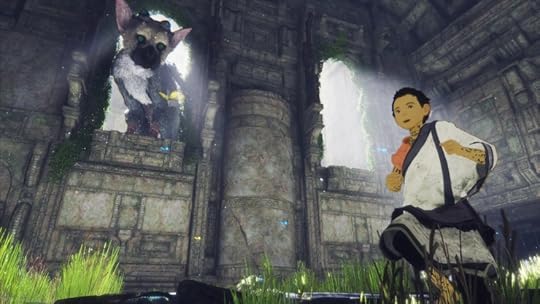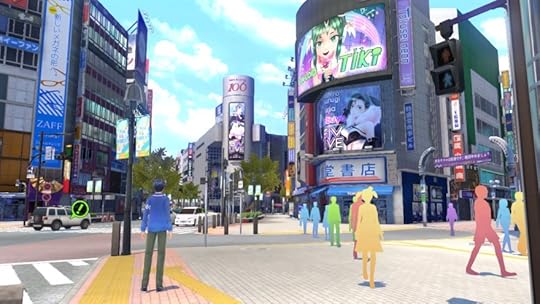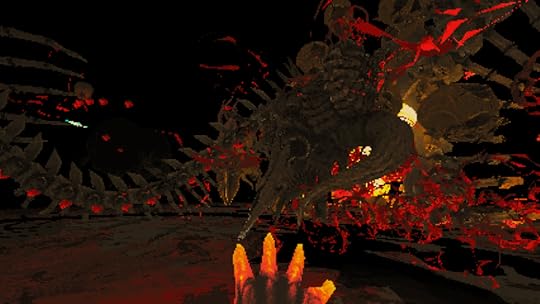Kill Screen Magazine's Blog, page 18
January 5, 2017
Ah, just what dystopian videogames need: acid humor
It’s no surprise that videogames are increasingly interested in matters of surveillance. After all, these days we can all feel like distant observers of each other’s lives, peeking in from the fringes provided by social media. There’s plenty of fiction from the 20th century that predicted our current circumstance: Nineteen Eighty-Four (1949), Brazil (1985), A Scanner Darkly (1977), and so on. Perhaps the only surprise is how willingly we submit our personal lives to the machines that are made to watch us.
Last year, videogames got serious on the subject, with harrowing thrillers like Replica, Orwell, Inside, and Watch_Dogs 2, which all took our monitored realities and stamped them with the word “DYSTOPIA” in wet red ink. But isn’t it all a little too obvious and somber? It’s not like these works of fiction across any medium (that includes you, Mr. Robot) is casting our lives in a light we’ve never seen before. We know we’re being observed and a lot of us don’t care. As that is the case, how can these narratives be the portents they seem to want to be?
there’s only so many dark skies and burning metropolises you can take
All I’m saying is that, hey, perhaps we could do with laughing at our shackled existence every now and then. Yeah? That’s why I’m interested in the upcoming “life-spotter simulator” titled Do Not Feed The Monkeys. It’s the next game by Fictiorama Studios, who has already participated in all the dystopian doom-and-gloom with its adventure game series Dead Synchronicity. But there’s only so many dark skies and burning metropolises you can take, I guess, which is why the Madrid-based team are making Do Not Feed The Monkeys now.
“One of the things we loved most when we came [up] with the idea of Do Not Feed The Monkeys was the chance it gives us to tell lots of different stories featuring lots of different genre: everyday stories, but also sci-fi, terror, comedy…,” said Luis Oliván, one of Fictiorama’s co-founders. Dead Synchronicity is thoroughly grim, dark, and deathly. But with Do Not Feed The Monkeys the team can leave that mindset and entertain a banquet of different tones, situations, even colors. It’s a palate cleanser.
It’s the format of Do Not Feed The Monkeys that lets it function as a kind of refreshment. It works by having you sit down in front of a monitor that shows you different camera feeds from around a city. This instantly gives Fictiorama a chance to go wild, offering a range of different subjects to monitor from your cozy spot, each feed a small story that can swing towards any genre they fancy. Taking a look at the screenshots that are currently available, you can see a horse-headed robbery going wrong, a janitor going crazy as he’s stuck in an elevator, and a cyclist who’s crashed into the front of a garbage truck.
a horse-headed robbery going wrong
With a healthy mix of dark humor and acid humor (jokes with ridiculous and abnormal thinking, such as might come from someone on acid), the team decided that only a vivid pixel-art style would match the chaotic nature of the game. “Besides, we also felt like working on a more comic art style, after working on the dark, geometric, expressionist style [of] Dead Synchronicity,” said Oliván. It’s also important to make sure that Do Not Feed The Monkeys is amusing enough just to look at without even interacting with it—the comic style visuals help to achieve that.
The reason that is wrapped up in the game’s title. The story goes that you join “The Primate Observation Club,” which gives you access to all of these camera feeds, but the caveat is that you do not get involved in the lives of the people you watch. You’re supposed to observe the monkeys (aka people) without interfering. But, as with the game Please, Don’t Touch Anything, the idea is for you to eventually give in to temptation. How you might get involved is to use the information you acquire through your observation to comb through social networking profiles, emails, and online documents. You can tamper with these things and doing so can affect the fate of your subjects.
But there’s a little more to the game than that. Other than getting caught for your interference, the other risk you run while playing Do Not Feed The Monkeys is negating your own well being. You have to decide to spend your money on buying more “cages” (aka camera feeds) or paying rent. You have to make sure you go to sleep so you don’t collapse from exhaustion, but what might you miss while snoozing? Monitoring your own health becomes a more important part of the game as you rack up the hours sat idle at the computer.
Fictiorama are focusing on getting the PC version of Do Not Feed The Monkeys finished and hope to get it out in 2017. They’re open to other platforms but can’t say anything about that yet.
You can find out more about Do Not Feed The Monkeys on its website.
The post Ah, just what dystopian videogames need: acid humor appeared first on Kill Screen.
Virtual pets get the creepy game they deserve
Sign up to receive each week’s Playlist e-mail here!
Also check out our full, interactive Playlist section.
Tattletail (Windows, Mac)
By Waygetter Electronics
The ’90s had a lot of creepy toys. Remember the adverts boasting that a new doll would actually crap in its diaper? What about those gross snot monsters that were made to let kids shoot slime at people? There were also virtual pets and Furbys. Remember those? A new horror game called Tattletail does. In fact, it has you looking after one over the nights leading up to Christmas. You have to feed and groom it, even play hide-and-seek, all so it keeps its loud mouth shut. If you don’t meet its needs then you’ll be easily hunted down by Mama Tattletail who comes out at night to find her children. Yes, it sounds a lot like Five Nights at Freddy’s, and the similarities can’t be denied. But Tattletail does perhaps have the additional function as an antidote to all the ’90s nostalgia of late. Some things are better left in the past.
Perfect for: ’90s kids, Furbies, horror fans
Playtime: 1-2 hours
The post Virtual pets get the creepy game they deserve appeared first on Kill Screen.
January 4, 2017
In Forgotten, you’re the horror inside the computer
“It’s now safe to turn off your computer.”
Anyone who owned a PC in the ’90s should be familiar with this strange statement. It only appeared once you’d instructed the computer to shut down. But now it also serves as the ending to Sophia Park‘s new Twine game, Forgotten. It’s a fitting closure given that you spend your time inside an old computer with a nearly exhausted hard drive. When you leave you have destroyed the last remnants of a virtual world and the inhabitants that had spent years dwelling within.
That final statement suggests that, after your cleansing (or destructive) act, it’s the first time in a long while that the computer could be considered “safe.” But the conversations you have with the desperate creatures before their eradication should sway your thoughts in other directions. You might not have realized what you were doing at first. Perhaps you tried to be civil and avoided using the “Attack!” command during conversations. Whether you did or didn’t, you can’t ignore the fact that you were referred to as “the reaper.” The computer might be safe when you’re finished but at what cost? The ‘safe spaces’ the computer provided for its previous occupants are all gone now.
“horror that comes from creating programmatic analogies to real life experiences”
“What really appeals to me, across all my work, is the particular kind of horror that comes from creating programmatic analogies to real life experiences,” Park told me. “The automatic operations that go on inside a computer can have real life equivalents … and when they don’t, they’re pretty horrific.” She explained how these analogies work by using her previous game Sonic OC 7 as an example. It has you talking with a ghost child through an obsolete chat system in which they seem to be trapped. As you talk with the child you can try to pry into their life or play along with a Sonic the Hedgehog-based role play. If you try to pry then the chat will break down and loop forever.
“The analogy I was trying to tackle is that the bad sectors on a hard drive—these blocks of space in the hard drive that your operating system has to just skip, until there are so many bad sectors that the hard drive stalls and stalls until it’s inoperable—it sounds a lot like trauma,” Park said. The idea in Sonic OC 7, then, is that the bad sectors on the hard drive are represented by the negative experiences in the ghost child’s life, and so they instantly reject your prying questions and scramble their digital memory when you try to get personal. The only way you can free the child and reach the ending is to fully engage with the Sonic role play.
Forgotten uses a similar analogy to Sonic OC 7. It was fueled by a specific set of questions that Park wanted to explore. They orbit around the idea of NPCs (non-player characters) in videogames gaining sentience and how their thoughts and actions be shaped by the computer’s resources. Here are the questions:
– Given enough loops, or enough time, how long would it take an NPC to become sentient? How old would the game have to be?
– Would that sentience take up RAM, or hard drive space?
– What if being sentient within those confines used up physical resources? What if thought ate up RAM? What if living in that world led you to view the things we do as programmers as actual magic? And what if that magic, in turn, ate up the same RAM you were using to think?
– What if their interactions were literally, absolutely defined within the confines of the game they lived in? What if they had to use up more of their physical resources to create a world without these limits on how they could interact?
Taking all these questions on board, Park imagined what the answers would be, and let that shape the world that you visit when starting up Forgotten. What this means is that the characters left in that world have become sentient (drawn by Arielle Grimes), have been living there for a long time, can only communicate by hurting each other (it’s the “rule” inside the RPG they live in), and have destroyed a lot of the available space by messing around with the code (which they think of as magic called “hex”).
comes back to bite you once you realize what you’ve done
You can pick all this up when playing the game if you follow the conversations closely enough. At one point, one character says to you: “When the others used hex, it ate the world. You could feel a little bit of the world vanish. There is less room for thoughts. The lights dim with the hex.” This is an explanation of how, when the NPCs found code, they used it to accidentally destroy the RAM.
When you arrive, you are taking up what’s left of the available spaces in the system’s memory, which brings about the destruction of the characters—you don’t need to issue an “Attack!” command to kill them off. And so it’s simply through your presence in the game that Forgotten finds its horror. It’s not a horror that puts you in any direct danger but one that comes back to bite you once you realize what you’ve done, even if it was an accident. You’re a monster and you didn’t know it until it was too late.
You can play and download Forgotten over on itch.io.
The post In Forgotten, you’re the horror inside the computer appeared first on Kill Screen.
RiME showcases the sights, sounds, and creatures of its Mediterranean fantasy
When RiME burst onto our radars with a minute-long trailer back in 2013, it showcased scenes that evoked games like Ico (2001) and The Wind Waker (2002). The camera swooped across a serene Mediterranean island with high walkways and cliff edges to traverse; there was an illusory door that opened into a mountain, where inside dark figures moved towards the protagonist’s campfire; it ended on a huge looming shape, dinosaur in size, moving through the veil of a morning mist.
All of that is present in RiME‘s new trailer but it also moves in closer, finally giving us a proper show of the protagonist’s face, as well as the creatures that he’ll encounter along his journey. Gulls and crabs populate the beach that the young boy washes up on after being shipwrecked. A little later, after passing by a huge tower, he finds a way to free a fox from its stony prison, bringing it back to life. The boy swims among tropical fish, down to the carcass of a shark, he’s chased by a large eagle-like bird, meets a bipedal robot, and also sees mysterious cloaked figures around the island. There are many sights to take in.
We don’t need to guess what is going on this new trailer as Tequila Works, the studio behind the game, has revealed all. Speaking to IGN, the studio explained that the boy has to make use of “light, sound, perspective and even time” to uncover the island’s secrets. He has to deal with the wild creatures and master the crumbling ruins of a long-forgotten civilization that are spread across the terrain.
you should notice details you might not have before
Take a second look at the trailer with this knowledge and you should notice details you might not have before. See how the sun and moon accelerate as he pushes a large circular device. Watch for the light beams being shot through the apertures atop the island’s large towers. And how the sound spirits emitted by crystal balls seem to bring a tree into full blossom.
The other bit of news that has arrived alongside this new trailer is that RiME is now confirmed to be coming out in 2017 for PlayStation 4, Xbox One, PC, and Nintendo Switch. We found out last year that the game dropped its PlayStation 4 exclusivity but this is the first time we’ve heard what other platforms it’s coming to.
You can find out more about RiME on its website.
The post RiME showcases the sights, sounds, and creatures of its Mediterranean fantasy appeared first on Kill Screen.
Yep, Jenny LeClue will still be your teen girl detective for 2017
Oh, look at that, it’s 2017. You want some new games to look out for this year? Well, my dear, let’s start by focusing our lens on the upcoming teen girl detective game Jenny LeClue.
Its creator Joe Russ has re-confirmed to me that Jenny LeClue will be out for Steam later this year. It will also be coming to PlayStation 4 and mobile but only after the Steam version is out. Got that? Good.
However, you don’t need to wait any longer to actually play the game. There’s a playable teaser of Jenny LeClue available on itch.io that is meant to give you an idea of its atmosphere. It puts you on the hunt for the journal of Professor Zazer, breaking into and creeping around his office to gather clues as to its whereabouts. You won’t get much of an idea of the game’s storytelling techniques—which include manipulating a meta-narrative, searching environments to inform dialogue choices, and forking path decisions—but the puzzle design and handmade art is very much on display in this teaser.
it’s actually quite adult in places
To give you an idea of the broader plot of Jenny LeClue, it takes place in the town of Arthurton, where not much happens and where Jenny resides in boredom. But then her mother is accused of murder and so Jenny jumps at the chance, not only to absolve her mother of the accusation, but to go on an adventure. As Jenny is still a teen, there’s some coming-of-age lessons wrapped up in her pursuit, mostly about the blurry lines between right and wrong. Oh, and while it may look like a darling, with its sharp cartoonish visuals, it’s actually quite adult in places exploring themes of death, loss, and family.
Russ was also kind enough to send over seven new images from the game. Together they showcase a graveyard scene that you’ll presumably have to explore with Jenny in the full game. Let’s go through them below:
Not much going on here but I do enjoy the stencil-cut of those roadside trees. The cop car’s siren appears to be on, too, so I guess they’re on the way to a crime scene … the graveyard?
This looks like the entrance or exit of the graveyard. That big imposing iron gate, with mist creeping out from under, and those bold lights making it resemble a face.
Oh, Jenny, looks like you’ve found some ghostly fungi clinging to that tree. Enjoying that blue crescent moon in the sky too.
A statue with a sword in one hand while the other points towards a set of stairs. Hmm. Do you trust that statue or not? Maybe just take a break on the bench.
Hmm, another statue. This one looks the same BUT it has ivy growing down it and is pointing in a different direction. Still creepy.
Ah-ha, see that staircase, is this where that first creepy statue was pointing to? Get busy detecting Jenny, the ancient spirits demand it!
And our final shot sees Jenny without her flashlight, alone among the gravestones and bare, crooked trees reaching out like terrible fingers. Ain’t looking good, girl.
You can find out more about Jenny LeClue on its website. The game is coming to Steam, PlayStation 4, and mobile in 2017. There’s a playable teaser available on itch.io.
The post Yep, Jenny LeClue will still be your teen girl detective for 2017 appeared first on Kill Screen.
January 3, 2017
Surreal horror game OMORI won’t be a recluse forever
OMORI isn’t dead but it has been delayed again. The team behind the upcoming “surreal psychological horror RPGmaker game” has released a new trailer and explained why the game isn’t out yet. To make a long story short: the team admits it “underestimated the amount of time to create a video game.” The original estimate for the game’s release date when it was funded on Kickstarter was May 2015. That means that prediction is drawing close to being two years early.
But there’s more to it than mere naivete. One of the major setbacks for the OMORI team has been a transfer in engines. As explained in the Kickstarter update, at one point the team decided to upgrade from RPGMaker VX Ace to RPGMaker MV, meaning that Mac would be available as an additional platform. It also meant that, when it is released, OMORI should run on many more computers. “If we stuck with our previous deadlines, OMORI had a large chance of not running at all on most computers and would not receive any updates to resolve these issue,” wrote the team.
The change in engines seems to have caused a right headache for the team. Not only were there new bugs to tackle, but the graphical engine needed to be upgraded and a lot of their work had to be reformatted, plus the newer engine uses a different programming language, which has caused an urgent need for some extreme resource management. “We hope that everyone understands that we are far from slacking off on this project and have been extremely busy working on the game while keeping up-to-date with everything technically,” wrote the team. “As we have mentioned before, some of us have even been developing health problems related to overworking and stress.
Videogames don’t often acknowledge hikikomori
As work on the game is still very much in the aftermath of that engine transfer, there’s no set release date for OMORI presently. But, hey, that gives you plenty of time to get familiar with it if you aren’t already. It takes place in “WHITE SPACE,” where the main character has apparently been hanging out for years by themselves, never leaving. The new trailer teases a Carroll-esque journey outside of that room, across pastel playgrounds, dark corridors, where there will be beasts to battle and friendly picnics available to break up the pace.
To elaborate a little on what the trailer shows, we can turn to the game’s description, which suggests that the main character is on a journey to discover their life before they were locked up in that room. There’s also something more morbid to unravel: “The truth is… Your story is already over. You just have to remember it,” goes the description.
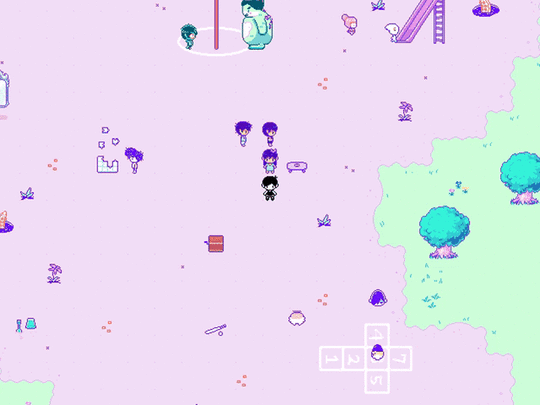
RPG Maker games have had a tacit association with this mixture of surrealism and teenage ennui since at least 2004, which was when Yume Nikki first appeared. If you’re unfamiliar, Yume Nikki is a surreal horror story about a hikikomori character—a term from Japan that refers to modern-day hermits. Videogames don’t often acknowledge hikikomori, but there’s an unexplained wealth of titles that were made using RPG Maker that do. OMORI is the next big hikikomori game to look out for.
Perhaps it’s the accessibility of RPG Maker, making it fairly easy for a single person to make an entire game, that has allowed this sub-genre to flourish. People who shut themselves in all day can make a game with a character that relates to them and their experiences without the help of anyone else. That seems to have been the case with Kikiyama, the mysterious creator of Yume Nikki, who disappeared from the internet before Yume Nikki was finished. Hopefully that won’t be the case with OMORI—the team does at least talk about their work and seem committed to see it to the end.
You can find out more about OMORI on its website.
The post Surreal horror game OMORI won’t be a recluse forever appeared first on Kill Screen.
December 30, 2016
High Scores: The Best Videogames of 2016 – 4 to 1
This is part of Kill Screen’s list of the best videogames of 2016. To see the rest of the list, check out all the other parts.
///
4. Anatomy
If Kitty Horrorshow is the new mistress of videogame horror, then right now Anatomy is her masterpiece. It’s as unsettling as it is smart. You’re tasked with collecting cassette tapes around a dark, silent house. As you listen to them, a monologue suggests the house is alive. One line that sticks: “There is even a fair number of comparisons to be drawn between those organs of the house and those of the human body.” The architectural space becomes a site of implied body horror.
Horrorshow knows she needn’t do much more to escalate the terror—your devilish imagination does that for her. But where Anatomy excels is its adaptation of the VHS aesthetic. It’s not that the game begins with a blue screen as if a recorded home video, distorted by tape chew and scanlines. Anatomy moves VHS horror beyond corrupted image data to make it structural. You’re required to play the game four times to reach its haunting end. The house appears to awaken, growing in power with each replay, throwing the experience into disarray. You can’t help but question the trust you place in your own house afterwards.
By Chris Priestman
3. Kentucky Route Zero Act IV
We are spoiled by Kentucky Route Zero. Every couple of years, another installment appears, simply plopped on the collective stoop of videogame culture without so much as a knock at the door. Act 4 begins to bend in on itself, swapping the immediate appeal of Act 3’s celestial musical number and self-referential adventure game-within-a-game for obscure experiments in poetry, cinematography, and the (deep breath) very act of seeing itself.
Onetime protagonist Conway recedes into the background; he is a smeared blot of paint on an ever-growing canvas. We descend further into the underground. The final shot pulls up, up, up through a long rickety staircase, our ragtag band of misfits and drifters pinned to the ground as we leave them. We have one more reunion to look forward to.
By Zach Budgor
2. Overwatch
There is nothing especially revolutionary in the grand strokes of Overwatch’s design, but in the execution of that design it is unmatched. Team Fortress 2 gave us the class-based shooter while ultimates—Overwatch‘s game-changing abilities—were borrowed from the MOBA genre, thank you very much. But like a cocktail by a master mixologist, Overwatch somehow manages to become more than the sum of its parts.
The power of the game isn’t just in its remarkable polish, though, no matter how much I fancy the way Junkrat’s grenade launcher jostles with explosive 8-balls as he hobbles across the map. Look at the colossal stores of fanart the game has accumulated so far, or the esport scene, which has rocketed to popularity at a higher rate than any competitive game ever. This year, the whole world fell in love with Overwatch—Kill Screen included.
By Roy Graham
1. Inside
What does Inside mean? The question has been reverberating around skulls since it came out. Perhaps the answer can be found in the rotten carcass of a pig? Or it lies with the fish in the flooded halls of the facility? That you can pry into Inside until your eyes are bloodshot and still dig up tiny details is testament to its brilliance. Did you know that, if you wait long enough, the photographs in the dark room will develop? The clues never stop.
But the answer still doesn’t come. It’s likely that there isn’t one. Inside makes a canvas out of its ambiguity. What you see in it is a reflection of your own worldview. Some might see it as an essay on the modern Orwellian circumstance. Others will remember it as a videogame about videogames. Perhaps the only certain statement that can be said is that it’s an exercise on control. And an exquisite one at that. Try to find a tighter game this year. You won’t. Inside draws together the multiple disciplines that videogames demand and nails every single one. It’s a game that will be studied and appreciated for years to come.
By Chris Priestman
The post High Scores: The Best Videogames of 2016 – 4 to 1 appeared first on Kill Screen.
December 29, 2016
High Scores: The Best Videogames of 2016 – 8 to 5
This is part of Kill Screen’s list of the best videogames of 2016. To see the rest of the list, check out all the other parts.
///
8. Hitman
What have I done? I accidentally killed this golf instructor in Sapienza—automatically a huge knock on my final score—and I feel terrible. This dude wasn’t my intended target. I just wanted his outfit. As I don this mystery man’s uniform, I wonder; what was this man’s life like before I threw a knife into his head? Before I, the ever-bald and temporarily golf-loving Agent 47, placed an exploding ball onto an isolated tee and gazed coldly from afar as it blew my mark to bits. Did the golf instructor I accidentally murdered have children? A cute dog? I’ll never know the life of this golf man whose identity I’ve assumed. I’ll only know the bad score I get for fucking up. Yes—Hitman is a good game.
By Caty McCarthy
7. Quadrilateral Cowboy
One of my favorite developers on Twitter is Brendon Chung. He has a knack for finding the beauty in any game—even the ones no one likes. The dresser drawers in Homefront: The Revolution. The variations of sliding across cars in Mafia III. Chung sees the most minute of details and celebrates them. Chung’s latest game, Quadrilateral Cowboy, is about those details, right down to your deck’s clunkily analog feel. From executing and eventually learning command line inputs to playing badminton with your trio of down-and-out hacker comrades, Quadrilateral Cowboy is a celebration of videogames and interactivity, right down to that very last heist.
By Caty McCarthy
6. Duskers
Duskers feels like an old friend you still hang out with. You can return to it at any time and leave again knowing it was a wholesome visit. It’s also the heavyweight champion of flickering interfaces and white-noise terror. Sat at your monitor, you type commands to your cast of drones, collecting salvage from derelict spaceships. It’s perfect at what it does. You ride on the hope that one day you’ll find another survivor among the wreckages of space. But Duskers in turn feeds on this longing, producing what is best described as a rare, potent type of isolation horror.
By Chris Priestman
5. Oxenfree
We all know an Alex. Hell, we all were an Alex once. Stubborn, kind, sarcastic, bitter, and everything in between. Alex is familiar because she was us. And that’s what Oxenfree understands about teenagers. At the start of the game, Alex and her gaggle of friends, family, and haters set out for a typical night on an island. Then things take a turn for the supernatural—of the ghosts, possessions, and downright eerie variety.
Still, Oxenfree is a game about grief. The haunted spaces of Edwards Island draw out the best and worst in Alex and her friends. The island is strange, dark, seemingly without hope—an echo of the characters’ struggle with the loss of Alex’s older brother, and Alex’s stepbrother’s deceased mother. Oxenfree stands firm as a smart supernatural tale that crawls to a chilling end without any melodrama. And it happens to have the most authentic teens in games to boot.
By Caty McCarthy
The post High Scores: The Best Videogames of 2016 – 8 to 5 appeared first on Kill Screen.
December 28, 2016
High Scores: The Best Videogames of 2016 – 12 to 9
This is part of Kill Screen’s list of the best videogames of 2016. To see the rest of the list, check out all the other parts.
///
12. The Last Guardian
You don’t mind when Trico delays the journey to splash in a puddle. This large mythic fusion of cat, bird, and dog is the most lovable videogame companion yet—both daft and majestic. Tasked with escaping a megastructure made of carved stone and rickety wooden plinths, the boy and Trico learn to cooperate, but also to care for one another. They climb up high and fall back down, over and over, participating in a thrilling drama punctuated by epic heights and the occasional stroke under the chin.
By Chris Priestman
11. Hyper Light Drifter
What Hyper Light Drifter “does” is simple: it stitches a Zelda-style world with a taut combat system and paints the whole thing in lurid pixel art. Why it works so well is a different story. It’s a game of details; of anime-scale apocalyptic signifiers like ruined giants and massive beating hearts, of the plaintive and swelling strains of Disasterpeace’s music, of characters who speak in painted images, not words. Hyper Light Drifter makes you an outsider in its world; it’s confident you’ll want to discover more for yourself.
By Zach Budgor
10. Firewatch
In the pastel mountains of the beautifully stylized Shoshone National Forest, a story born from the loneliness and austere beauty of Campo Santo co-founder Sean Vanaman’s Wyoming childhood plays out. Firewatch isn’t the first game to have all the hallmarks of great writing—humor, pathos, a compelling enigma. But the first game from Campo Santo was special because it dared to do something so few games do: it treated its players like adults, resisting the easy closure of a happy ending.
By Roy Graham
9. Tokyo Mirage Sessions #FE
Tokyo Mirage Sessions #FE is a gift from the JRPGods. Like someone up above gazed down and said, “What do you want in a JRPG?” And the world answered back, “A Shin Megami Tensei game with all of Persona’s social sim elements, but also dungeon crawling, Fire Emblem fan service, and Idolmaster character drama!” Tokyo Mirage Sessions is a much-needed breath of fresh air in a year of repeated disappointments in the genre (looking at you, I Am Setsuna and Final Fantasy XV). It’s the type of JRPG that, contrary to the traditions of its namesake series, is never a chore to play. No dungeon crawl is a slog. No sidequest feels needless. Tokyo Mirage Sessions is a beat you’ll want to dance to all night long.
By Caty McCarthy
The post High Scores: The Best Videogames of 2016 – 12 to 9 appeared first on Kill Screen.
December 27, 2016
High Scores: The Best Videogames of 2016 – 16 to 13
This is part of Kill Screen’s list of the best videogames of 2016. To see the rest of the list, check out all the other parts.
///
16. Abzû
Abzû is an underwater opera about the precious cadence of ecosystems. Its ocean world feels like a fantasy as you swim downstream with dolphins and weave between the tropical leaves of aquatic plants. But for the most part it is not. The game only takes what beauty already exists (or once did) in the seas and attaches a full-blown orchestra to it. In a year when scientists have announced the human impact on the coral reef is driving it to extinction, it’s a vital commemoration.
By Chris Priestman
15. VA-11 HALL-A
Cyberpunk is dead. We live in the zone now, jacked in every second of every day. The failure of modern cyberpunk is a failure to engage with that reality, instead falling headfirst into gangrenous nostalgia for a fictional future. VA-11 Hall-A is different. It lures you in with those seductive aesthetic markers—neon, synthesizers, Blade Runner noir, you know the drill—and then tells a resonant, intimate human story with wit, waifus, and warmth to spare.
By Zach Budgor
14. Dishonored 2
The word at the heart of Dishonored 2 is ‘clockwork’. Not because of its new clockwork soldiers or the indelible Clockwork Mansion. It’s a game of many moving parts and is therefore not without its frictions. But the memorable moments feel close to genius: time-shifting through a decrepit manor, stalking the strata of the Addermire Institute, the traffic of people aboard the Dreadful Wale. When everything locks into place it’s as if some grand machine is firing on all cylinders. And when you perform assassinations from careful planning and spontaneous accidents, you feel like its masterful engineer.
By Chris Priestman
13. Devil Daggers
The modern shooter has gone astray, and you may not realize this until you play Devil Daggers. It resets the genre back to year zero. There’s no bullshit here. Survive for as long as you can, locked in an eternal struggle with a hell fleet of bony centipedes and churning flocks of skulls. This is its demand. So you dance and die around its abyssal arena as if caught in some back-pedalling tornado. Slowly you learn to move better, to bounce off the goddamn floor, to duck under the snarling horrors and to press deeper and harder until you find it: shoot-’em-up bliss.
By Chris Priestman
The post High Scores: The Best Videogames of 2016 – 16 to 13 appeared first on Kill Screen.
Kill Screen Magazine's Blog
- Kill Screen Magazine's profile
- 4 followers






